
10.6.2 - Flashing indicator
During the manoeuvre the flashing indicator flashes once every second.
When something is wrong the flashes are more frequent (every half sec-
ond); the light flashes twice with a second’s pause between flashes, see
Table 12
.
ECSBus LED [A]
Off
The led flashes slowly
On
One flash every second
2 long flashes
1 flash every 5 seconds
Series of flashes separated
by a pause
Fast flashing
Status
Malfunction
Serious malfunction
All OK
The status of the inputs has changed
Automation in “standby” mode
This is the same signal as on the flasher,
see
Table 12
ECSBus short circuit
Action
Make sure there is power supply; check to see if the fuses are
blown; if necessary, identify the reason for the failure and then
replace the fuses ones of the same type.
There is a serious malfunction; try switching off the control unit
for a few seconds; if the condition persists, it means there is a
malfunction and the circuit board has to be replaced.
Normal operation of control unit
This is normal when there is a change in one of the inputs: OPEN,
STOP, triggering of photocells or the radio transmitter is in use.
All OK; when a command arrives, the control unit will reset to
normal functioning (after a brief delay).
An overload has been detected and therefore the power supply
to the ECSBus has been turned off. Check, possibly by discon-
necting each device one at a time.
To switch on power to the ECSBus you simply need to give the
command, for example, using the radio transmitter.
TABLE 13 (fig. 40)
LED STOP [B]
Off
*
On
Status
Activation of the STOP input
All OK
Action
Check the devices connected to the STOP input
STOP Input active
LED OPEN [C]
Off
On
Status
All OK
OPEN input activation
Action
OPEN input not active
Normal only if the device connected to the OPEN input is defi-
nitely active.
10.6.3 - Control unit
The control unit has a series of LEDs, each of which can give particular
signals both during regular operation and when there is a problem, see
Table 13
.
Quick flashes
1 flash
1 second pause
1 flash
2 flashes
1 second pause
2 flashes
3 flashes
1 second pause
3 flashes
4 flashes
1 second pause
4 flashes
5 flashes
1 second pause
5 flashes
6 flashes
1 second pause
6 flashes
7 flashes
1 second pause
7 flashes
8 flashes
1 second pause
8 flashes
9 flashes
1 second pause
9 flashes
Status
Error on ECSbus
Triggering of a photocell
Action of the “motor force” limiting device
Activation of the STOP input
Error in the internal parameters of the electronic
control unit
The maximum manoeuvre limit/hour has been
exceeded
There is an error in the internal electric circuits
A command that does not permit other com-
mands to be performed is already present
The automation is locked
Action
At the beginning of the manoeuvre, the verification of the devices
present does not correspond to those learned; check and possibly
try to redo the learning (10.3.3 “Recognition of other devices” ).
Some faulty devices may be present; check and replace them.
At the start of the manoeuvre, one or more photocells are pre-
venting movement; check to see if there are any obstacles. Dur-
ing the movement, although the obstacle is effectively present, no
action is required.
During the movement, the gate experienced excessive friction;
identify the cause.
At the start of or during the manoeuvre, the STOP input was acti-
vated; identify the cause.
Wait at least 30 seconds, then try giving a command; if the con-
dition persists it means there is a serious malfunction and the
electronic board has to be replaced.
Wait for a few minutes until the manoeuvre limiting device drops
to under the maximum limit.
Disconnect all the power circuits for a few seconds and then try to
give the command again. if the condition persists it means there is
a serious malfunction and the electronic board has to be replaced
Check the type of command that is always present; for example,
it could be a command from a timer on the “open” input.
Release the automation by sending an automation release com-
mand to the control unit.
TABLE 12
English
22
– English









































